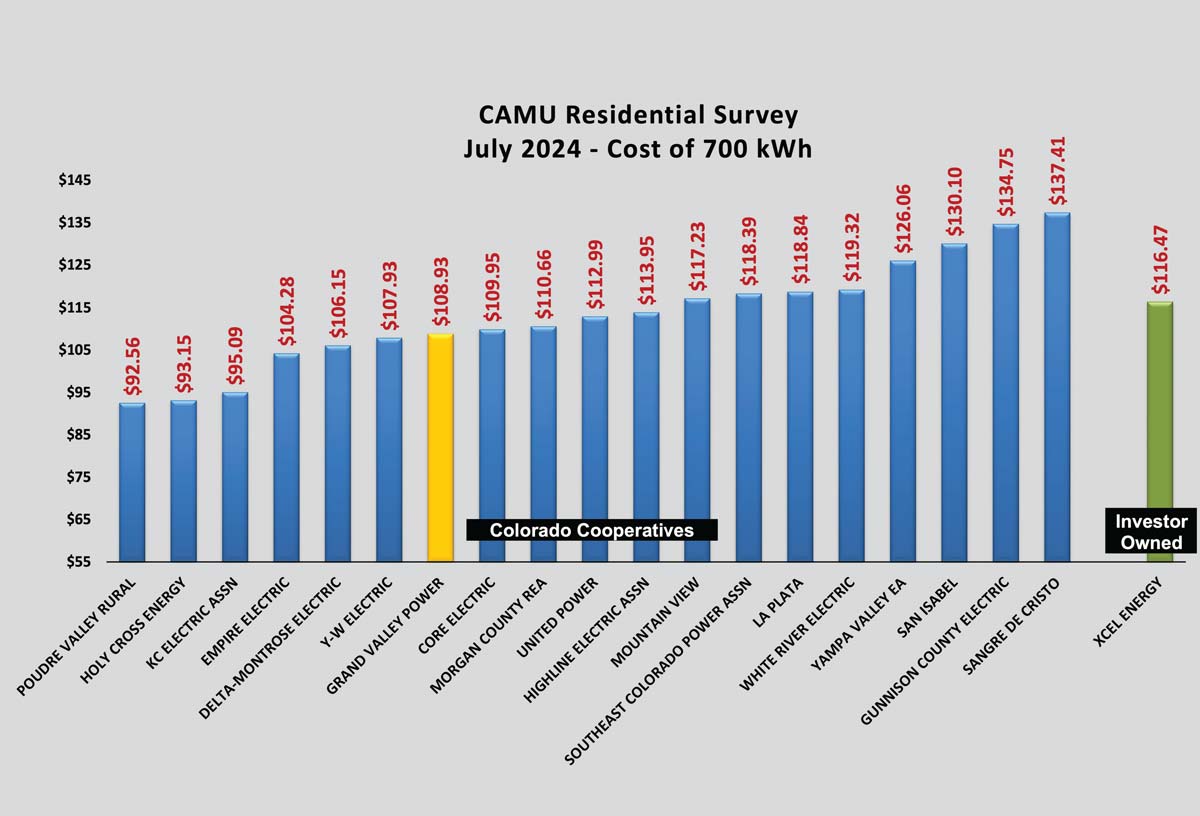GVP Serves Meat and Potatoes to Members
by Tom Walch, Chief Executive Officer
GRAND JUNCTION, COLO. - (November 11, 2024) The meat and potatoes job of every rural electric cooperative is to provide reliable, affordable, and safe power for its members. This has always been a challenging job, and it isn’t getting any easier. Grand Valley Power does a great job with reliability. While we have had some challenges in 2024, we routinely rank among the best in the state of Colorado for keeping the lights on. We have made great strides in safety, culminating recently when we received the Colorado Rural Electric Association annual Achievement of Excellence Award for Performance in Safety. That leaves us with … affordability.
At GVP’s last annual meeting I addressed a question raised by a member who asked why different electric cooperatives have different rates. My smart aleck answer: Different cooperatives have different rates because they are different.
In all seriousness, there are a number of things that factor into the costs co-ops incur serving their members, as well as the rates co-ops charge to recover those costs. Much of it has to do with economies of scale. Bigger co-ops that have more consumers and more commercial and industrial loads can typically operate a little more efficiently and keep costs a little lower. Then there is load. Smaller co-ops that serve smaller loads have more of a challenge. Another big factor is density. Co-ops that serve remote areas have greater costs and fewer consumers to help pay those costs. Some of it has to do with climate. Co-ops that have hot summers and large air-conditioning loads generally have higher wholesale power costs because they place more demand on the system on hot days. The amount of distributed generation — rooftop solar — can impact a co-op’s operating costs. And different co-ops have different wholesale power arrangements that can impact their costs.
The inquiring member asked why GVP’s rates were higher than those of other Western Slope cooperatives. I noted that in GVP’s case, the factors that impact our costs and our rates include the following:
- We get a higher percentage of our revenue from residential consumers than any other co-op in Colorado; on the flip side, we don’t have as much commercial and industrial load to help cover our costs.
- We serve a lot of remote areas with challenging terrain. Think about serving consumers on Glade Park, on the Grand Mesa, or at the end of Unaweep Canyon. That’s a lot of cost, and not a lot of cost recovery.
- Our power costs are driven by air-conditioning load during hot summer months, when wholesale power costs are at their highest. This isn’t an issue that consumers at co-ops like Holy Cross Energy in Glenwood Springs or La Plata Electric Association in Durango — where the summers are cooler — have to deal with.
- We have the highest penetration rate of rooftop solar of any cooperative outside of the Denver metro area. This causes a cost shift that impacts our rates.
Despite these challenges, we haven’t increased our rates in almost two years. Our rates compare favorably with most of our peers on this side of the divide. Here you can see data from a survey conducted by the Colorado Association of Municipal Utilities that compiles and compares the rates charged by participating utilities across the state. If you look at all the co-ops on or near the Western Slope, GVP’s residential rates are lower than those at Yampa Valley Electric, White River Electric, La Plata Electric, Gunnison County Electric, Sangre de Cristo Electric, and San Isabel Electric.

Having said all this, we know that keeping our power costs affordable — back to our meat and potatoes — is important to our members. That’s why our board took the big step to exercise a contract option and terminate power purchases from Xcel, effective in 2028. That’s why we signed a new power supply agreement with Guzman Energy — this will help keep our rates stable and affordable.
And speaking of Xcel, there’s a remarkable data point on the CAMU rate survey. Note that Xcel charges its retail customers $116.47 for 700 kilowatt-hours of electric energy — more than $7.50 more per month for the same amount of energy from GVP. Given all the advantages Xcel has — density, load, economies of scale — and even with a vertical monopoly by virtue of owning and operating its own generation and transmission facilities, Xcel’s retail residential power costs are higher than ours. I have been tracking the CAMU rate comparison for more than a dozen years, and this is the first time that our rates have been lower than Xcel’s retail residential rates.
What does this mean for you? It means that GVP is successfully executing on its core job providing reliable, affordable, and safe power for our members. It is the meat and potatoes of what we do, and on the Western Slope, it is what matters most.
